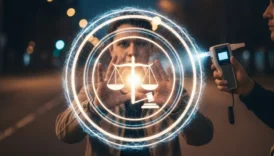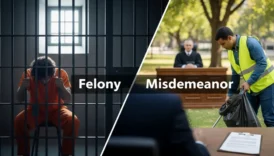How Does Bail Work in Criminal Cases?

Bail is a legal mechanism that allows a person accused of a crime to be released from custody while awaiting trial, under the condition that they return for future court proceedings. It acts as a financial or legal guarantee to ensure the defendant’s appearance in court, balancing the individual’s right to freedom with the justice system’s need for accountability. While bail is common in many criminal cases, how it works—and who qualifies—depends on several factors, including the severity of the charges, the defendant’s criminal history, and jurisdictional laws.
What Is Bail in Criminal Law?
In criminal law, bail refers to the conditional release of a defendant from custody while awaiting trial. Instead of remaining in jail until the court date, the defendant is allowed to return to the community under certain conditions, usually involving a financial guarantee. This guarantee ensures that the defendant will return to court as required and comply with the law during their release.
Core Definition
- Bail is essentially a security deposit for freedom.
- The court sets an amount of money or other conditions that must be satisfied before release.
- If the defendant attends all hearings and follows the rules, the bail is refunded (or the obligation is discharged). If they fail to appear, the bail is forfeited, and an arrest warrant is issued.
Legal Basis
The right to bail is recognized in most legal systems, though the specifics vary. In the United States, for example, the Eighth Amendment prohibits excessive bail, ensuring that bail amounts are fair and proportional. However, it does not guarantee bail in every situation—especially for serious crimes or where defendants pose a flight risk.
Practical Example
Suppose a person is arrested for burglary. Instead of being held in jail for months until the trial, the judge sets bail at $10,000. The defendant (or their family) can pay the bail, and the defendant is released. If the defendant returns for trial, the money is returned. If not, the money is forfeited, and the defendant faces additional legal consequences.
Key Elements of Bail
- Temporary Freedom: Bail allows defendants to continue their lives, work, and prepare their defense outside of jail.
- Guarantee of Appearance: The primary purpose is to ensure the defendant appears at all required court dates.
- Conditional Nature: Bail may come with additional requirements such as travel restrictions, curfews, or no-contact orders with victims.
Why Bail Matters
Bail is critical because it reflects the principle of “innocent until proven guilty.” Without bail, individuals could remain incarcerated for long periods before trial, even if they are later found not guilty. At the same time, bail balances this right with society’s interest in ensuring defendants face justice.
In short: Bail in criminal law is a system that provides temporary freedom under conditions designed to protect the judicial process and public safety.
The Purpose of Bail
The bail system exists to balance two important goals of the criminal justice system: protecting the rights of the accused and ensuring the integrity of the judicial process. While bail often takes the form of money, its true purpose goes beyond financial considerations.
1. Ensuring Court Appearance
The primary purpose of bail is to guarantee that defendants return for their scheduled hearings and trial. By requiring a financial or legal stake, the court creates an incentive for defendants to appear. If they fail to do so, they risk forfeiting the bail amount and being rearrested.
2. Preserving the Presumption of Innocence
Defendants are legally presumed innocent until proven guilty. Keeping individuals in jail before trial contradicts this principle, especially when trials can take months or even years. Bail allows defendants to maintain their freedom while still facing charges.
3. Protecting Public Safety
In some cases, bail is set with conditions designed to safeguard the community. For example, a defendant charged with domestic violence might be released on bail only if they agree to a no-contact order with the alleged victim. In more serious cases, bail may be denied altogether if the defendant poses a significant risk to others.
4. Allowing Defendants to Prepare Their Defense
Defendants out on bail can consult more freely with attorneys, gather evidence, and continue their personal and professional lives while awaiting trial. Being in custody can make building a strong defense far more difficult.
5. Reducing Jail Overcrowding
By permitting pretrial release, bail also reduces the burden on jails. Without bail, detention facilities would be overwhelmed with individuals awaiting trial, many of whom may ultimately be acquitted.
Practical Example
Consider a defendant arrested for fraud. If bail is set at $50,000, the court’s intent is not just to impose a financial burden but to ensure that the defendant attends future proceedings. At the same time, bail conditions might restrict travel to prevent flight risk.
Key Takeaway
The purpose of bail is not punishment—that comes only after conviction. Instead, it serves as a tool to ensure defendants respect the legal process, protect communities, and uphold fundamental rights. Properly applied, bail strikes a balance between individual liberty and public interest.
How Bail Is Set by the Court
When someone is arrested, one of the first questions is whether they can be released on bail, and if so, at what amount. The process of setting bail is not random—it follows established legal standards designed to balance the defendant’s rights with the court’s need to ensure future appearances and protect the community.
Initial Bail Hearing
After an arrest, defendants typically appear before a judge or magistrate within a short period—often 24 to 48 hours. During this hearing:
- The judge reviews the charges.
- The prosecution may argue for a higher bail (or no bail at all).
- The defense may argue for lower bail or release on personal recognizance.
- The judge ultimately sets the bail amount and any conditions of release.
Key Factors Judges Consider
Judges evaluate several factors when determining bail:
- Nature and Severity of the Offense
- Serious crimes (like violent felonies) often result in higher bail or denial of bail.
- Minor, nonviolent offenses may allow for low bail or release without payment.
- Criminal History
- A defendant with a history of failing to appear in court is more likely to face higher bail.
- First-time offenders may be treated more leniently.
- Flight Risk
- If the defendant has strong community ties (job, family, residence), bail may be lower.
- If the defendant has a history of fleeing or ties abroad, bail may be set higher or denied.
- Public Safety Concerns
- If releasing the defendant poses a danger to others, the judge may impose strict conditions or deny bail altogether.
- Financial Resources
- Courts consider the defendant’s ability to pay. Excessive bail is prohibited under the U.S. Constitution, so judges try to set amounts proportionate to means.
Bail Schedules
In many jurisdictions, bail schedules provide standard amounts for common offenses. For example:
| Offense Type | Typical Bail Amount |
|---|---|
| DUI (first offense) | $5,000 |
| Burglary | $20,000 |
| Assault with a weapon | $50,000 |
| Drug trafficking | $100,000+ |
These amounts can be adjusted by the judge depending on case-specific factors.
Example Scenario
A defendant arrested for burglary may have bail initially set at $20,000 per the schedule. If the defendant has a steady job, no criminal history, and strong local ties, their attorney may argue for a reduced bail amount—or even release on personal recognizance.
Key Takeaway
Bail is set through a combination of legal guidelines and judicial discretion. The goal is to ensure the defendant’s return to court and protect the community, without imposing bail so high that it effectively results in pretrial detention.
Types of Bail in Criminal Cases
Bail is not a one-size-fits-all concept. Courts use several different types of bail depending on the circumstances of the case, the defendant’s background, and the jurisdiction’s laws. Understanding these types helps clarify how bail functions in practice.
1. Cash Bail
- The defendant (or someone on their behalf) pays the full bail amount in cash.
- If the defendant attends all court appearances, the money is refunded (minus any administrative fees).
- Example: A $5,000 bail is paid directly to the court. If the defendant complies with all conditions, the money is returned after trial.
2. Bail Bond (Surety Bond)
- If the defendant cannot afford the full bail amount, they may use a bail bondsman.
- The bondsman charges a non-refundable fee (often 10% of the bail) and posts the remainder with the court.
- Example: For a $50,000 bail, the defendant pays a bondsman $5,000. The bondsman guarantees the rest.
3. Property Bond
- Instead of cash, the defendant pledges property (such as real estate) equal to the bail amount.
- If the defendant fails to appear, the court may seize or foreclose on the property.
4. Personal Recognizance (Release on Own Recognizance, or ROR)
- In some cases, defendants are released without paying money, based solely on their promise to appear in court.
- This is more common for minor offenses and when the defendant has strong community ties.
5. Unsecured Bond
- The defendant signs a bond promising to pay a certain amount if they fail to appear.
- No upfront payment is required, but the defendant owes the money if they violate bail conditions.
6. Conditional Bail
- The court sets non-financial conditions along with or instead of monetary bail.
- Examples: travel restrictions, surrendering passports, curfews, drug testing, or no-contact orders with victims.
7. Federal Bail (Pretrial Release Conditions)
- In federal cases, bail often involves strict supervision rather than large sums of money.
- Defendants may be subject to electronic monitoring, regular check-ins, and other restrictions.
Practical Illustration
Imagine two defendants arrested for the same crime—drug possession:
- One has stable employment, no prior record, and strong family ties. The judge may grant release on recognizance.
- The other has a history of missing court dates. Bail is set at $25,000, and the defendant must either post cash, property, or use a bondsman.
Key Takeaway
The type of bail reflects both the risk posed by the defendant and the court’s effort to balance freedom with accountability. Some defendants may secure release with no money at all, while others face high financial or conditional barriers depending on the seriousness of their case.
The Role of Bail Bondsmen
Not every defendant can afford to pay their bail in full. In cases where bail is set at thousands—or even hundreds of thousands—of dollars, many defendants turn to bail bondsmen (also called bail agents) for help. Bail bondsmen play a unique role in the criminal justice system, providing a way for defendants to secure release even when they lack the financial means.
How Bail Bondsmen Work
- Fee Payment
- The defendant (or their family) pays the bondsman a non-refundable fee, usually around 10% of the bail amount.
- Example: If bail is $50,000, the defendant pays the bondsman $5,000.
- Surety Bond Issued
- The bail bondsman provides a surety bond to the court, guaranteeing that the full bail amount will be paid if the defendant fails to appear.
- Release of the Defendant
- Once the bond is posted, the defendant is released from custody under the same conditions as if they had posted full bail themselves.
Responsibilities of a Bail Bondsman
- Monitoring Defendants: Bondsmen often check in with clients to make sure they attend court dates.
- Recovering Fugitives: If a defendant skips bail, the bondsman may hire a bounty hunter (in jurisdictions where it is legal) to locate and return the defendant.
- Financial Liability: The bondsman is responsible for paying the full bail if the defendant fails to appear and cannot be recovered.
Advantages for Defendants
- Provides a realistic option for those who cannot afford full bail.
- Ensures quicker release from jail, allowing defendants to return to their families, jobs, and legal preparations.
Drawbacks of Using Bail Bondsmen
- The fee paid to the bondsman is non-refundable, even if the defendant is acquitted or the case is dismissed.
- Defendants may be required to provide collateral (property, vehicles, jewelry) to secure the bond.
- Bondsmen may impose strict conditions or monitoring requirements.
Example Scenario
A defendant is arrested for fraud and bail is set at $100,000. They cannot pay in full but contact a bail bondsman. The family pays the bondsman $10,000 (non-refundable). The bondsman posts the bond, and the defendant is released. If the defendant fails to appear in court, the bondsman could lose the full $100,000 unless they locate and return the defendant.
Key Takeaway
Bail bondsmen provide a bridge between defendants and the courts, making bail accessible to those who otherwise could not afford it. However, the system raises questions about fairness, as wealthier defendants can pay bail directly and recover their money, while poorer defendants lose the non-refundable fee.
Factors That Influence Bail Decisions
Judges do not set bail amounts arbitrarily. Instead, they weigh several important factors to determine whether bail should be granted, at what amount, and under what conditions. These considerations are designed to balance the defendant’s right to freedom with the court’s duty to protect the public and ensure justice.
1. Nature and Severity of the Offense
- Felonies vs. Misdemeanors: Serious crimes, such as armed robbery or homicide, typically result in higher bail amounts—or even denial of bail—compared to minor offenses like petty theft.
- Violent vs. Nonviolent Crimes: Violent crimes often carry stricter bail requirements because of the risk to community safety.
2. Flight Risk
- Community Ties: A defendant with strong local connections—family, employment, residence—is seen as less likely to flee.
- Past Behavior: A history of missed court appearances raises red flags and can increase bail or result in denial.
- Resources to Flee: Wealth, access to travel documents, or international ties may suggest a higher risk of escape.
3. Criminal Record
- Defendants with lengthy criminal histories are often considered higher risks, particularly if they have committed similar crimes in the past.
- First-time offenders may receive more leniency in bail amounts or conditions.
4. Public Safety Concerns
- Judges must consider whether releasing the defendant poses a danger to the community.
- In domestic violence cases, for example, judges may impose protective orders as a condition of bail.
- For particularly dangerous defendants, bail may be denied entirely.
5. Evidence and Strength of the Case
- If the prosecution presents strong evidence suggesting a high likelihood of conviction, judges may set higher bail to reduce the temptation for the defendant to flee.
6. Statutory Guidelines and Bail Schedules
- Many jurisdictions use bail schedules—pre-set amounts for common offenses—as a starting point.
- Judges can adjust these amounts based on case-specific factors.
7. Defendant’s Financial Resources
- Courts must balance bail amounts so they are not “excessive” under constitutional standards.
- A wealthy defendant may face higher bail to make the guarantee meaningful, while a low-income defendant may receive a reduced amount or alternative conditions.
Example Scenario
Two individuals are arrested for the same offense—burglary.
- Defendant A has a steady job, no prior record, and a family in the community. The judge sets bail at $10,000 with the option of release on recognizance.
- Defendant B has prior convictions and a history of failing to appear in court. The judge sets bail at $50,000 or denies bail altogether.
Key Takeaway
Bail decisions hinge on a combination of risk assessment and fairness. Judges aim to protect the public and ensure defendants return to court while also respecting the principle that bail cannot be excessive or punitive.
What Happens If Bail Is Violated?
Bail comes with obligations. When defendants are released, they agree not only to appear in court but also to comply with any conditions set by the judge. If those conditions are violated, the consequences can be immediate and severe, potentially making the defendant’s legal situation much worse.
Types of Bail Violations
- Failure to Appear (FTA)
- The most common and serious violation.
- If a defendant misses a scheduled court date, bail is usually revoked, and a bench warrant is issued for their arrest.
- Breaking Bail Conditions
- Conditions may include travel restrictions, curfews, avoiding contact with victims, or submitting to drug tests.
- Violating these terms—even without missing court—can lead to bail revocation.
- Committing New Crimes
- If the defendant is arrested for a new offense while out on bail, judges often revoke bail and order detention until trial.
Legal Consequences of Violations
- Forfeiture of Bail Money
- If cash bail was posted, the money is forfeited to the court.
- If a bail bond was used, the bail bondsman becomes liable for the full amount and may pursue the defendant for reimbursement.
- Re-arrest and Jail Detention
- A warrant is issued, and the defendant is taken back into custody.
- Judges are less likely to grant bail again, or they may impose higher amounts and stricter conditions.
- Additional Charges
- In some jurisdictions, failure to appear or violating bail terms can lead to new criminal charges, separate from the original case.
Impact on Legal Strategy
Violating bail damages the defendant’s credibility in court. Judges and prosecutors may view them as unreliable, which can negatively affect plea negotiations and sentencing outcomes.
Example Scenario
A defendant charged with fraud is released on bail with a condition not to contact former coworkers. If the defendant violates this order by sending threatening emails, the judge can revoke bail, issue a warrant, and order the defendant to remain in custody until trial.
Key Takeaway
Violating bail undermines the court’s trust and can turn a manageable situation into a far more serious one. Defendants not only risk losing money but also face re-arrest, stricter conditions, or even new criminal charges. Compliance with bail terms is essential for protecting both freedom and legal standing.
Alternatives to Bail
While traditional cash or bond-based bail is common, many courts also rely on alternatives to reduce jail populations, lower costs, and ensure fairness for defendants who cannot afford bail. These alternatives are designed to maintain accountability while still honoring the principle of “innocent until proven guilty.”
1. Release on Recognizance (ROR)
- The defendant is released based on their promise to return to court without paying money.
- Often granted to first-time offenders, those charged with minor offenses, or individuals with strong community ties.
- Example: A college student arrested for a nonviolent misdemeanor may be released on recognizance if the judge believes they are unlikely to flee.
2. Supervised Release
- Instead of money, defendants are monitored by pretrial services officers.
- Conditions may include check-ins, home visits, or progress reports.
- This option reduces jail overcrowding while still keeping track of defendants.
3. Conditional Release
- Defendants may be released with specific conditions designed to address risks.
- Examples:
- Travel restrictions.
- No-contact orders with alleged victims.
- Regular drug or alcohol testing.
- Curfews enforced by electronic monitoring.
4. Unsecured Bonds
- Defendants sign an agreement to pay a certain amount if they fail to appear in court.
- No upfront payment is required, but noncompliance makes the defendant financially liable.
5. Pretrial Diversion Programs
- In some cases, especially for minor offenses, defendants may enter programs focused on rehabilitation.
- Example: A first-time drug offender may enter a treatment program instead of posting bail, with charges dismissed upon completion.
6. Community-Based Alternatives
- Nonprofits or community bail funds sometimes step in to pay bail for low-income defendants, reducing the inequities of the cash bail system.
Advantages of Bail Alternatives
- Fairness: Prevents wealthier defendants from having an unfair advantage over poorer ones.
- Cost Savings: Reduces the financial burden on both defendants and taxpayers funding jail detention.
- Rehabilitation Focus: Some alternatives prioritize treatment and social support over detention.
Example Scenario
A defendant arrested for shoplifting cannot afford the $2,000 bail set by the court. Instead, the judge releases them under supervised release, requiring weekly check-ins with a pretrial officer. This ensures accountability while avoiding unnecessary incarceration.
Key Takeaway
Alternatives to bail demonstrate that money is not the only way to ensure compliance. By offering release options based on supervision, conditions, or community ties, the justice system can balance fairness, efficiency, and public safety more effectively.
Criticism and Reform of the Bail System
The bail system, while intended to balance individual freedom and public safety, has faced growing criticism for being unfair, inconsistent, and overly dependent on wealth. Critics argue that it often punishes the poor, favors the wealthy, and contributes to overcrowded jails. As a result, many jurisdictions are exploring reforms to make the system more equitable.
Major Criticisms
- Wealth Disparity
- Wealthier defendants can post bail quickly and return to their normal lives.
- Poorer defendants may remain in jail for months, even for minor offenses, simply because they cannot afford bail.
- Impact on Legal Outcomes
- Defendants held in jail are more likely to plead guilty—sometimes just to secure release, even if they are innocent.
- Pretrial detention can negatively influence case outcomes, as juries may perceive jailed defendants as more likely to be guilty.
- Overcrowding in Jails
- A large portion of jail populations consists of individuals awaiting trial, not yet convicted of a crime.
- This strains resources and increases taxpayer costs.
- Reliance on Bail Bondsmen
- The commercial bail industry profits from defendants’ misfortune.
- Families often lose money permanently through non-refundable fees, even when defendants comply with all court requirements.
- Inconsistency Across Courts
- Bail amounts can vary dramatically for similar offenses, depending on the judge, jurisdiction, or use of bail schedules.
Reform Efforts
- Risk Assessment Tools
- Some courts use algorithms to evaluate flight risk and danger to the community, rather than setting bail amounts arbitrarily.
- Eliminating Cash Bail for Minor Offenses
- Jurisdictions like New Jersey and New York have reduced reliance on cash bail for nonviolent crimes.
- Instead, defendants may be released under supervision or recognizance.
- Community Bail Funds
- Nonprofit organizations raise money to post bail for low-income defendants, helping level the playing field.
- Focus on Alternatives
- Expansion of supervised release, electronic monitoring, and diversion programs reduces dependence on money-based bail.
Example of Reform in Practice
In 2017, New Jersey overhauled its bail system, largely eliminating cash bail. Instead, judges rely on risk assessments and impose conditions like electronic monitoring or mandatory check-ins. The reform reduced pretrial jail populations without increasing crime or missed court dates.
Key Takeaway
The bail system’s critics see it as a system of inequality, where freedom before trial depends more on financial means than justice. Reform efforts aim to create a fairer process that respects constitutional rights while maintaining public safety.
Final Thoughts on Bail in Criminal Justice
Bail plays a vital role in the criminal justice system by balancing two competing goals: protecting individual liberty and ensuring accountability within the legal process. While the system has flaws and faces criticism, it remains a cornerstone of how courts manage pretrial release.
Why Bail Matters
- For Defendants: Bail ensures that people are not unjustly held in jail for extended periods before trial, allowing them to maintain employment, family life, and the ability to build a defense.
- For Courts: Bail serves as a practical tool to encourage defendants to return for hearings and trials.
- For Communities: Bail decisions, when properly made, protect public safety by keeping high-risk individuals under closer supervision or denying bail altogether.
The Balance Between Rights and Risks
The concept of bail reflects the principle of “innocent until proven guilty.” Defendants are given the opportunity to remain free while their cases proceed, but they must respect the court’s authority by appearing when required. At the same time, judges have the responsibility to weigh public safety and the risk of flight.
The Ongoing Debate
- Supporters of bail argue it is necessary to maintain order, ensure court appearances, and give defendants a pathway to freedom before trial.
- Critics of bail contend that it unfairly punishes the poor, fosters inequality, and should be replaced with risk-based alternatives.
- As a result, many jurisdictions are experimenting with reforms, from reducing reliance on cash bail to using pretrial monitoring programs.
Looking Ahead
The future of bail in criminal justice will likely involve:
- Greater use of non-monetary release conditions such as electronic monitoring.
- More reliance on risk assessments instead of fixed bail schedules.
- Continued debate over the role of commercial bail bondsmen and whether the industry should remain central to the system.
Key Takeaway
Bail is not meant to be a punishment—it is a temporary safeguard. When applied fairly, it preserves freedom for the accused while upholding the integrity of the justice process. As reforms continue, the challenge will be ensuring that bail (or its alternatives) remains a tool of fairness rather than inequality.
Frequently Asked Questions (FAQs)
1. What is bail in criminal cases?
Bail is the temporary release of a defendant from custody before trial, usually secured by money or conditions, to ensure they return to court.
2. Is bail a right in all criminal cases?
Not always. While the law prohibits excessive bail, judges may deny bail in cases involving severe crimes, flight risks, or threats to public safety.
3. How does a judge decide the bail amount?
Judges consider factors like the severity of the offense, criminal history, flight risk, community ties, and the defendant’s financial situation.
4. Can bail be paid back?
Yes. If the defendant attends all required court dates, cash bail is usually refunded at the end of the case, minus administrative fees.
5. What happens if someone cannot afford bail?
They may remain in custody, use a bail bondsman (for a non-refundable fee), or request bail reduction or release alternatives from the court.
6. What is a bail bondsman?
A bail bondsman posts bail on behalf of a defendant for a fee (often 10% of the total bail). The fee is non-refundable, even if the defendant is acquitted.
7. Can bail conditions include restrictions besides money?
Yes. Judges can impose travel bans, curfews, drug testing, electronic monitoring, or no-contact orders as conditions of release.
8. What happens if bail conditions are violated?
The defendant may forfeit bail, be re-arrested, face additional charges, and lose the opportunity for release before trial.
9. Are there alternatives to traditional bail?
Yes. Options include release on recognizance (ROR), supervised release, unsecured bonds, and pretrial diversion programs.
10. Why is the bail system criticized?
Critics argue it unfairly disadvantages poor defendants, contributes to jail overcrowding, and ties freedom to wealth rather than risk. Many jurisdictions are pursuing reforms.






